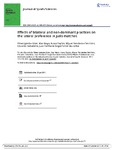Mostrar o rexistro simple do ítem
Effects of bilateral and non-dominant practices on the lateral preference in judo matches
| dc.contributor.author | Carballeira, Eduardo | |
| dc.contributor.author | Mayo, Xián | |
| dc.contributor.author | Dopico-Calvo, Xurxo | |
| dc.contributor.author | Fernández-del-Olmo, Miguel | |
| dc.contributor.author | Fariñas Rodríguez, Juan | |
| dc.contributor.author | Fernández Uribe, Sergio | |
| dc.date.accessioned | 2024-04-24T11:34:22Z | |
| dc.date.issued | 2018 | |
| dc.identifier.citation | Eliseo Iglesias-Soler, Xian Mayo, Xurxo Dopico, Miguel Fernández-Del-Olmo, Eduardo Carballeira, Juan Fariñas & Sergio Fernández-Uribe (2018) Effects of bilateral and non-dominant practices on the lateral preference in judo matches, Journal of Sports Sciences, 36:1, 111-115, DOI: 10.1080/02640414.2017.1283431 | es_ES |
| dc.identifier.issn | 0264-0414 | |
| dc.identifier.uri | http://hdl.handle.net/2183/36335 | |
| dc.description.abstract | [Abstract] : This study analysed the effects of bilateral and non-dominant practice on novice practitioners’ lateral preference for judo skills in a combat context (i.e., randori). Thirty sports sciences students (22 men and 8 women; mean age 19 ± 1 years) with right hand, foot, and counterclockwise rotation preferences were divided into 3 groups: bilateral (BG; n = 8), non-dominant (NDG; n = 11), and control (CG; n = 11). Participants received 8 weeks of training at a rate of 3 days per week. The NDG was trained to perform judo skills exclusive with their non-dominant side, while the BG performed every task symmetrically. Before and after training, participants were recorded during two 3-min randoris to obtain the percentage of their engagement in dominant side actions. Pretest percentages were 73.1 ± 19.9%, 77.8 ± 18.8%, and 68.9 ± 27.2% for BG, NDG, and CG, respectively. Post-test values were 75.0 ± 15.6%, 23.3 ± 27.9%, and 72.2.9 ± 20.4%, respectively. Significant differences were observed between NDG and each of the other groups after the training. Changes from pretest were onlysignificant for NDG (P = 0.003). These results suggest that lateral preference among novice judo practitioners during randori can be modulated by the type of practice. | es_ES |
| dc.language.iso | eng | es_ES |
| dc.publisher | Routledge | es_ES |
| dc.relation.uri | http://dx.doi.org/10.1080/02640414.2017.1283431 | es_ES |
| dc.rights | © 2017 Informa UK Limited, trading as Taylor & Francis Group | es_ES |
| dc.subject | Laterality | es_ES |
| dc.subject | Judo | es_ES |
| dc.subject | Motor learning | es_ES |
| dc.subject | Skills acquisition | es_ES |
| dc.subject | Sport skills learning | es_ES |
| dc.title | Effects of bilateral and non-dominant practices on the lateral preference in judo matches | es_ES |
| dc.type | info:eu-repo/semantics/article | es_ES |
| dc.rights.access | info:eu-repo/semantics/embargoedAccess | es_ES |
| dc.date.embargoEndDate | 9999/99/99 | es_ES |
| dc.date.embargoLift | 9999 | |
| UDC.journalTitle | Journal of Sports Sciences | es_ES |
| UDC.volume | 36 | es_ES |
| UDC.issue | 1 | es_ES |
| UDC.startPage | 111 | es_ES |
| UDC.endPage | 115 | es_ES |
| dc.identifier.doi | http://dx.doi.org/10.1080/02640414.2017.1283431 |
Ficheiros no ítem
Este ítem aparece na(s) seguinte(s) colección(s)
-
GI-PHG - Artigos [101]






